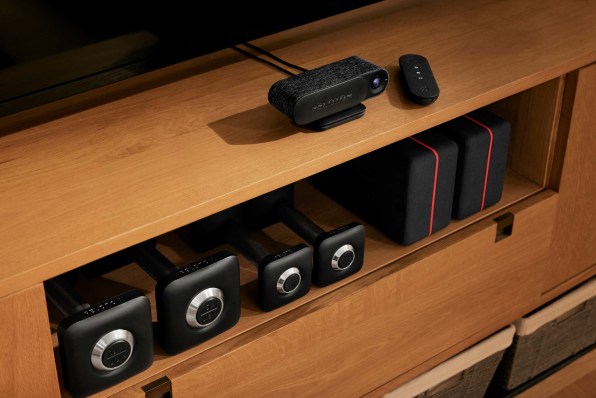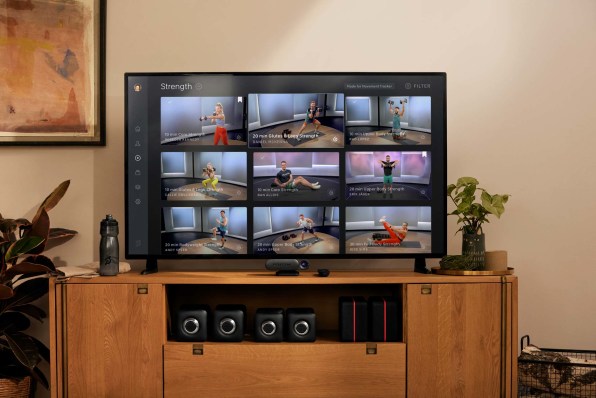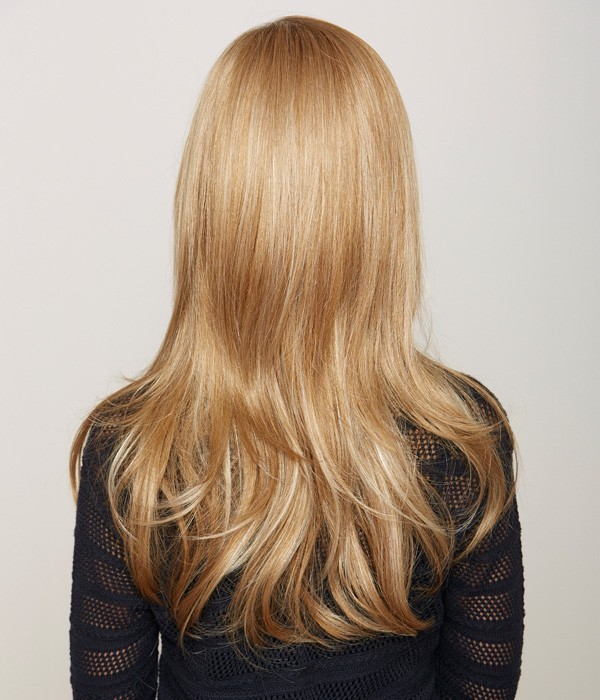[ad_1]
Fitness company Peloton announced Tuesday the launch of its most inexpensive offering yet: a $295 device called Peloton Guide, aimed at helping people improve their form during its workout classes. For the nearly one million people who subscribe to Peloton’s fitness classes and don’t own its equipment, the Guide could give them a reason to further invest in the platform.
The Peloton Guide’s camera—a small grey device wrapped in fabric with a 12.3 megapixel camera and a 120-degree field of view—is meant to sit on top of a television or monitor. The camera connects with your television to project your workout onscreen, right alongside your instructor, to help you compare form. For now, the Guide only offers strength-training classes (that includes Barre and Pilates). The company plans to expand the Guide functionality to other classes over time.

“We were hearing a lot from beginners that there was a lot of uncertainty around what certain movements even were,” says Ben Schultz, director of product management at Peloton. “Like, what is a bent-over row? What do I have to think about as I’m doing a bent-over row?” The Guide is the answer to that.
The device includes a number of features meant to help optimize your workout. First, it tells people what muscle groups they’ll be working, so they can choose what areas of their body they want to work on and have a sense of what muscles they should be feeling during their workout. Second, it tracks a user’s movements during the class and lets them know much they’re working. In addition, the Guide has a movement library, allowing people to practice movements outside of class. The device is also voice-activated (though this feature is in beta), so you can ask the Guide to scrub forward or backward during a class in order to get to the next movement. Finally, there is a movement tracker, which tracks your ability to complete a given exercise inside the instructor’s specified time frame.

Movement tracker is a motivational tool that acknowledges the effort users put into their class exercises. The app lets you know that it’s tracking your body, by putting a white box around it on screen. When the instructor kicks off a set of repetitions, the movement tracker will give a user credit for continuing to complete the given exercise for the duration of the set.
“It’s really looking for you doing the appropriate movement at a pace that makes sense for you at a form that works for your body for the full duration of time that the instructor is programming it,” says Schultz.

The Guide integrates with several consumer heart rate monitors and can display real-time heart rate data on screen as you’re working out. Peloton also has something called a “strive score,” which launched last year and rates a person’s workout effort using an individualized score, based on age, heart rate, and length of workout (it will also tell you how long you spent in each heart rate intensity zone). For those who are nervous about data privacy, all data is stored and processed on the device—it never goes to the cloud. The Guide also comes with a cover that can gently slide over the camera and cover it when it’s not in use (there is also a way to manually turn off the device’s microphone).

“If I tell you to straighten your back or sit up straight right now, you may not have an intuitive sense for which muscles you should tighten and loosen in order to achieve that posture,” says Schultz. “But if you can see yourself doing it and then make those adjustments, or see how those adjustments feel, that’s a much more powerful way of doing form correction.”
During the pandemic, Peloton saw a 120% rise in revenue as people rushed to purchase workout equipment amid lockdown restrictions (today, Peloton has 6.6 million members). But in 2021, Peloton’s Tread and Tread+ devices were recalled after 70 children were injured and one died. Then, amid cooling demand, the company announced earlier this year it would halt production of its bike and treadmill. The Guide marks a new opportunity for the company to try and engage new users and those who use Peloton Digital, its app-only offering, which has 862,000 members.
Peloton Digital, with its array of workout classes, was started as a supplement to its core offering of classes for Peloton’s bicycle and treadmill. It was for when members didn’t have access to their equipment or needed to squeeze in a quick workout that they could do anywhere. Now, the company sees this sort of supplemental exercise as core to the way people work out today. While Peloton’s treadmill ($2,500) and bike ($1,500) may be out of reach financially for many, $295 for the Guide may be a more justifiable expense, so long as Peloton can prove it really does help users improve their workouts.
Peloton’s Guide has a lot of room for expansion, not only adding the new features to other categories of workouts like pilates or yoga, but also to create more personalization (perhaps in addition to the strive score, Peloton might recommend target heart rates to reach). It is available for order starting April 5, for $295. Members can access classes for $24 per month.
[ad_2]
Source link



/assets/images/provider/photos/2672875.jpg)

More Stories
Leftover Makeover: Mashed Potato Ball Appetizer
5 major health benefits of tofu you probably didn’t know about
Gifts for Diabetics |